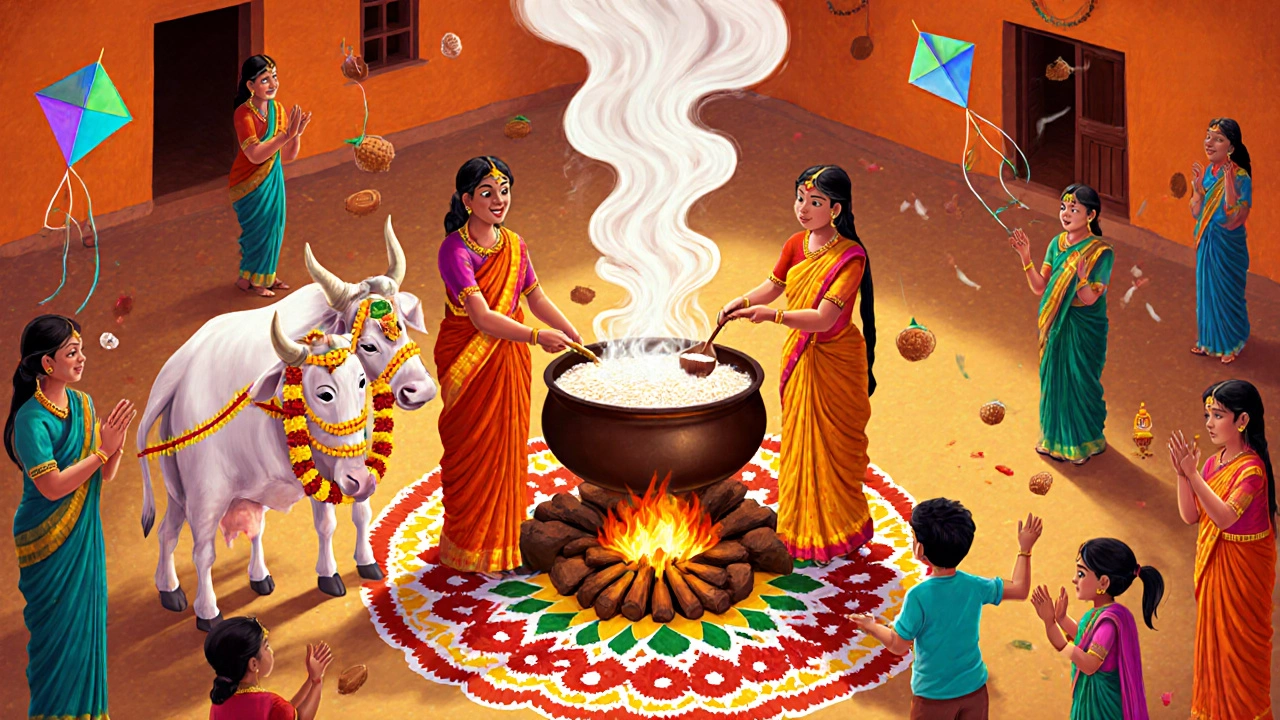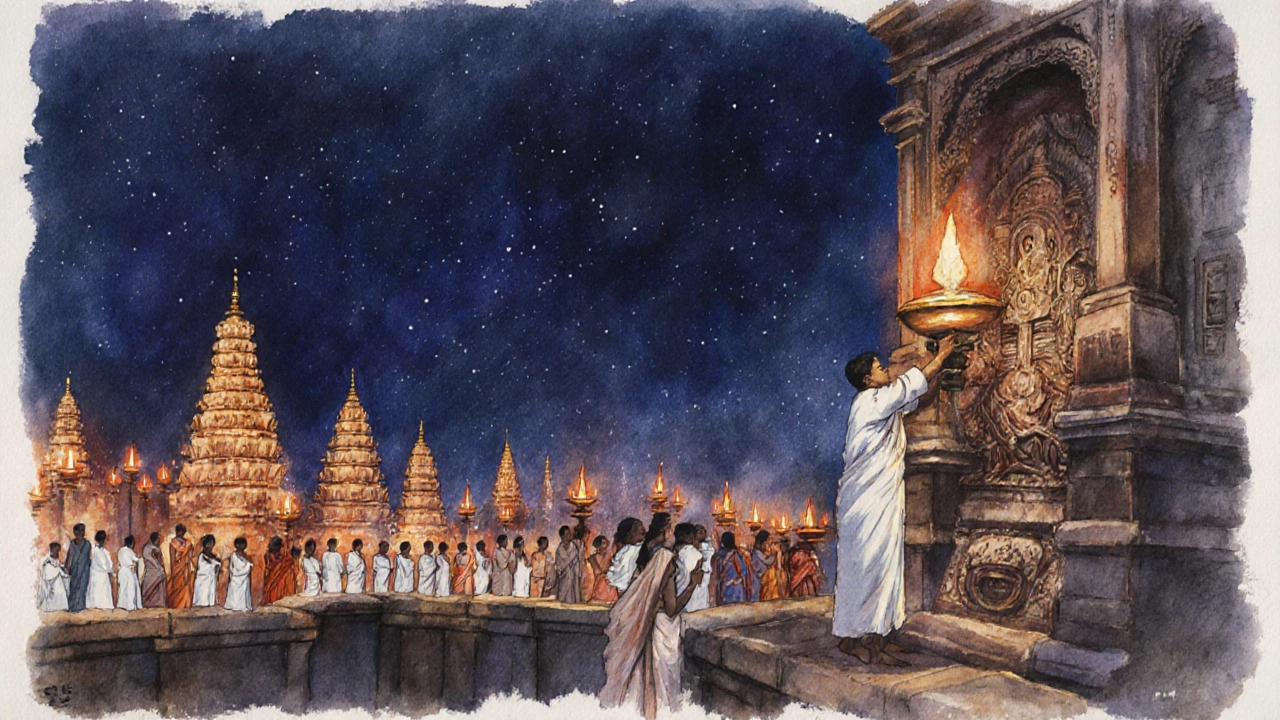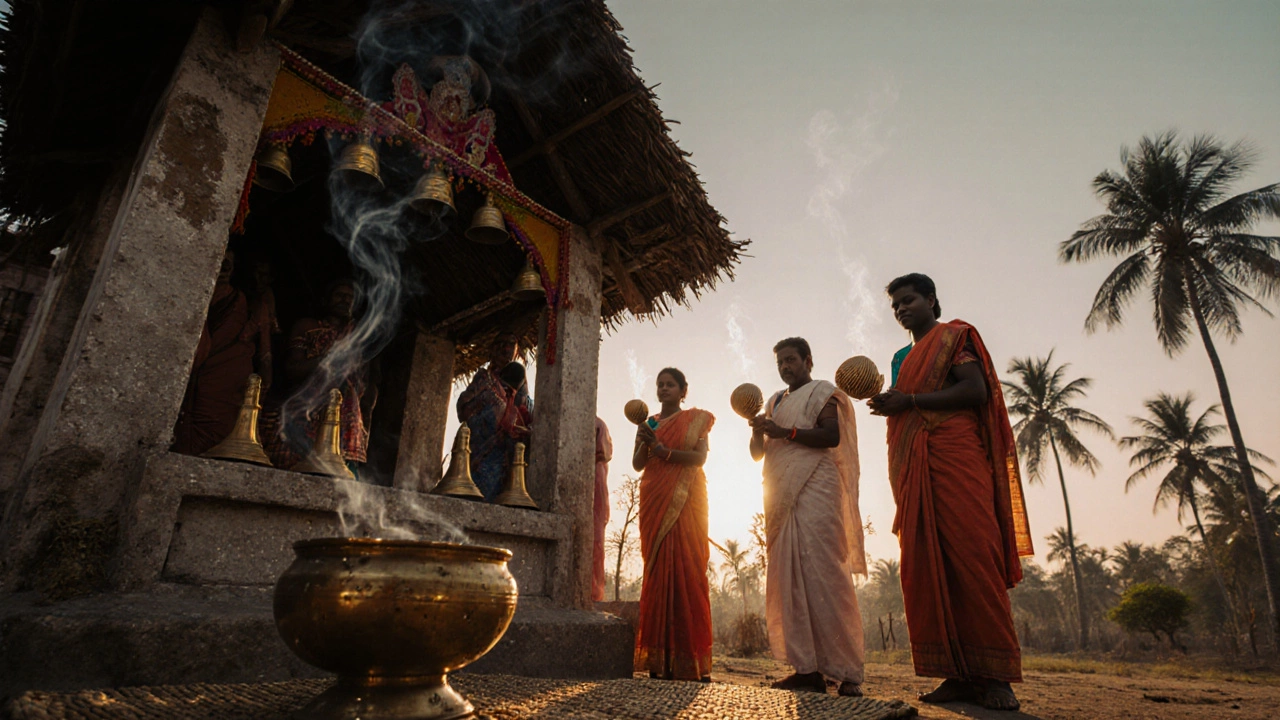Tamil Nadu Ritual Explorer
Select a ritual category below to learn more about its significance and practices.
Major Religious Festivals
Pongal, Karthigai Deepam, Navaratri, Thaipusam, Mariamman
Life-Cycle Rituals (Samskaras)
Birth, Coming-of-Age, Marriage, Death
Temple Daily Practices
Suprabhatam, Abhishekam, Alankaram, Arti
Folk and Community Rituals
Ther Thiruvizha, Kavadi Attam, Fire Walking, Street Drama
Common Elements & Symbolism
Natural elements, music, food offerings, colors, community
Quick Reference Table
Overview of key rituals and their occasions
Ever wondered what makes Tamil Nadu’s cultural calendar feel like a living museum? From sunrise prayers in a village shrine to grand festivals that light up entire cities, the state’s rituals weave together spirituality, community, and a love of seasonality. Below you’ll find a walkthrough of the most recognizable practices, the occasions that spark them, and the symbolic details that keep each tradition alive.
Major Religious Festivals
When talking about Tamil Nadu rituals, festivals are the first thing that spring to mind. They are not just holidays; they are structured rituals that follow precise timings, foods, and customs.
- Pongal is the four‑day harvest celebration that marks the sun’s northward journey (Uttarayan) and thanks the earth for its bounty. Families clean their homes, cook the iconic sweet rice dish called "pongal" in open pots, and worship cattle with elaborate decorations.
- Karthigai Deepam is the festival of lights celebrated on the full moon of the Karthigai month, featuring towering oil lamps (deepams) across homes and temple rooftops. The ritual mimics the ancient legend of Shiva’s divine flame and is a visual reminder of inner illumination.
- Navaratri is a nine‑night worship of the goddess Durga, observed with daily "kavadi" processions, music, and vibrant dance performances known as "kummi" in many Tamil villages. Each night focuses on a different aspect of the divine feminine, and devotees fast or abstain from certain foods.
- Thaipusam is a penance festival dedicated to Lord Murugan, where devotees carry "kavadi" (burdens) on their shoulders and sometimes pierce themselves with hooks and skewers as an act of devotion. The ritual culminates at the Palani temple, one of the most visited pilgrimage sites in the state.
- Mariamman Festival is a regional celebration honoring the rain‑bringing goddess Mariamman, featuring fiery fire‑walking ceremonies and communal feasts. Villages set up temporary shrines and chant rhythmic drums to invoke protection against disease.
Each of these festivals follows a set calendar based on the Tamil lunar months, and the rituals-whether lighting a lamp or preparing a special dish-serve as a shared language for the community.
Life‑Cycle (Samskara) Rituals
Beyond public celebrations, Tamil Nadu has a suite of personal ceremonies that mark the major milestones of an individual’s life. These are collectively called "samskaras" and are performed by the family, often with the guidance of a priest.
- Birth and Naming (Jatakarma & Namakarana): Immediately after birth, a newborn is bathed with water mixed with turmeric and oil. The baby’s name is announced in a ceremony called "Namakarana," where the first letter is chosen based on the mother’s star sign.
- First Rice Feeding (Annaprashana): Usually held at six months, the child is fed a spoonful of rice mixed with honey while family members chant blessings for health and wisdom.
- Coming‑of‑Age (Upanayana): Though more common among Brahmin families, many Tamil households observe a rite of passage where the boy receives the "yagnopavit" (sacred thread) and begins formal study of the Vedas.
- Marriage (Thirumanam): The wedding unfolds over multiple days. The ritual "Kanyadanam" involves the bride’s father handing her hand to the groom, while the "Muhurtham" (auspicious moment) is chosen based on astrological charts. The ceremony concludes with the couple stepping over a rice‑filled pot, symbolizing prosperity.
- Death (Antyeshti): The last rites involve cremation on a designated pyre, accompanied by recitations of "Garuda Purana" verses. Family members scatter the ashes in the river or sea, believing it helps the soul’s journey.
These samskaras reinforce a sense of continuity, linking each person to generations past and to the larger cultural fabric of Tamil Nadu.

Temple Daily Practices
Temples across Tamil Nadu operate on a precise schedule, turning worship into a daily ritual that blends devotion with ritual hygiene.
- Suprabhatam is the early‑morning hymn that awakens the deity, performed with conch shells and bells. Priests chant verses while sprinkling holy water (theertham) on the idol.
- Abhishekam is the ritual bathing of the deity using milk, honey, ghee, and sandalwood paste, each representing purity, sweetness, richness, and fragrance. The offering is believed to transfer the divine essence to the worshippers.
- Alankaram is the adorning of the deity with new clothes, flowers, and jewelry before the main puja. This process underscores the belief that gods deserve respect akin to a human guest.
- Deepa Seva is the offering of oil lamps, where devotees light multiple wicks as a sign of gratitude and ask for illumination in their lives.
- Arti and Prasad Distribution: The day ends with a collective chant (arti) and the distribution of "prasad"-typically sweetened rice or coconut chutney-believed to carry the deity’s blessings.
These daily actions repeat with clockwork precision, creating a rhythm that synchronizes the temple’s spiritual atmosphere with the surrounding community.
Folk and Community Rituals
Not every ritual is tied to a temple or a calendar date. Many are rooted in local folklore, agricultural cycles, or community solidarity.
- Ther Thiruvizha (Chariot Festival): Massive wooden chariots carrying deities are pulled through town streets, accompanied by traditional drums and folk dances. The event fosters a shared sense of identity.
- Kavadi Attam: Aside from the Thaipusam pilgrimage, some villages hold “Kavadi” dance competitions where participants mimic the burden‑carrying steps to earn divine favor for an upcoming harvest.
- Village Fire‑Walking (Theppam): During the Mariamman Festival, devotees walk barefoot across hot embers, a ritual believed to cleanse sins and invite protection from disease.
- Street Drama (Therukoothu): Performers enact mythological stories on temporary stages, using music, masks, and exaggerated gestures. The shows often conclude with a blessing chant for the audience.
These practices keep oral traditions alive, allowing younger generations to experience cultural heritage in a tangible way.

Common Elements and Symbolism
While each ritual has its own script, several threads run through almost every ceremony in Tamil Nadu:
- Use of Natural Elements: Water (for purification), fire (for transformation), and earth (for grounding) appear in almost every rite.
- Music and Rhythm: From the beating of the "thaali" (ankle bells) in dance to the chanting of Vedic hymns, sound is a conduit for spiritual energy.
- Offerings of Food: Sweet rice, fruits, and jaggery are recurring gifts, symbolizing abundance and the sweetness of life.
- Color Significance: Red denotes fertility and power, while yellow (turmeric) stands for purity and auspiciousness.
- Community Participation: Even the most private samskara often involves extended family or neighbors, reinforcing social bonds.
These shared motifs help outsiders recognize the underlying unity among seemingly disparate ceremonies.
Quick Reference Table
| Ritual Category | Typical Occasion | Main Activities |
|---|---|---|
| Harvest Festival | Pongal (mid‑January) | Cooking sweet rice, cattle worship, house cleaning |
| Light Festival | Karthigai Deepam (November‑December) | Lighting oil lamps, temple fire rituals |
| Life‑Cycle Samskara | Birth, marriage, death | Bathing, naming, thread ceremony, prasad distribution |
| Temple Daily | Every morning & evening | Suprabhatam, abhishekam, alankaram, arti |
| Folk Community | Ther Thiruvizha, fire‑walking | Chariot procession, drum circles, dance |
Frequently Asked Questions
What is the significance of cooking pongal during the festival?
The sweet rice dish symbolizes the sun’s generosity and the farmer’s gratitude for a bountiful harvest. The pot is left to boil over, signifying abundance spilling over into the coming year.
How is a Tamil wedding different from other Indian weddings?
Tamil weddings emphasize the "muhurtham" (auspicious timing) chosen by a star‑based calendar, and the ritual "kanyadanam" where the bride’s father formally gives her hand to the groom. The ceremony also includes a unique rice‑filled pot that the couple steps over together.
Why do devotees walk on fire during the Mariamman Festival?
Fire‑walking is viewed as a test of faith. Successfully crossing the flames is believed to purify the body, ward off disease, and earn the goddess’s protection for the village.
Can non‑Tamils participate in these rituals?
Most public festivals welcome anyone who respects the customs. Private samskaras, like naming or marriage, are usually limited to families following the Hindu tradition, but friends can attend as guests.
What are the typical foods offered as prasad?
Common prasad includes sweet rice, jaggery cubes, coconut chutney, and fruits like banana and mango. The offerings are usually simple, vegetarian, and prepared without onions or garlic.
By understanding the rhythm behind these practices, you’ll see how Tamil Nadu’s rituals are more than isolated events-they’re a continuous dialogue between people, nature, and the divine.
